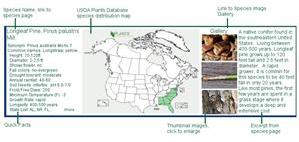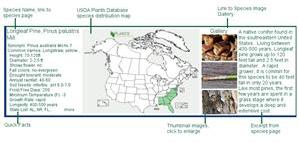



Pines might be the most economically important timber tree in
North America. They are used as lumber, pulpwood, furniture
and more. Also, they have ethnobotanical value for the turpentine
produced by distilling the resin. In the past, it was used in
treatments for a variety of ailments like respiratory issues, skin
problems, and even tuberculosis at one time. Native Americans
along the Pacific used the pitch to waterproof canoes and glue
feathers to arrow shafts. Fresh boughs were often brought inside
to freshen and fragrance the air. Some native tribes ground the
inner bark into meal for bread making or soup thickening. Pine
trees also have edible seeds and in North America Pinyon pine
seeds are usually harvested for human consumption.
Species of the pine family are characterized by having needles and cones; although varied between species and genus. Native members of the Pine family are in all corners and habitats of North America from the swamps of Florida to the high elevations in the Rockies, all the way north into Canada and Alaska. They have developed remarkable adaptations for survival and domination, like cones that survive and only open with fire, chemicals that keep certain trees from being able to grow nearby and compete for resources, and extended periods of growth dormancy (over 100 years!) until conditions are favorable for growth.
North American Native Pine (Pinaceae) Family

Want to add your tree to our picture gallery? Click here for details!
Tree lists:
•A-Z by scientific
name
•A-Z by common
name
•By Family
For state A-Z list click state name below.
•A-Z by scientific
name
•A-Z by common
name
•By Family
For state A-Z list click state name below.
-Color denotes a tree that is rare or endangered

Pine (Pinus)

Spruce (Picea)
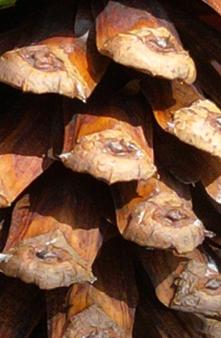
Longleaf pine cone, TreesForMe image
Please see usage requirements
Please see usage requirements
Reaching astonishing heights, some North American native pine trees are among the tallest in the world.
The Ponderosa pine (pinus ponderosa), native to the west coast, is the tallest conifer in North America,
growing over 240 feet tall. On the east coast, the tallest conifer is the Eastern White Pine, pinus strobus,
hitting the 180 foot mark. Prior to the colonization of North America, it is believed this tree was much
larger. If stature alone isn't enough, there is even a native pine species that grows cones weighing 5
pounds! That would be the female cones of the Coulter Pine (Pinus coulteri), endemic to California. These
are the heaviest pine cones in the world. North America is also home of the longest pine cone in the
world, the title going to the Sugar Pine (Pinus lambertiana). Also native to the west coast, Sugar pine
cones reach up to 26 inches in length. That's over 2 feet of pine cone!
Generally, pine trees are characterized by having cones and needles but with such physical diversity
within the genus, each tree needs its own description. Some have single needles while others are
bundled in fascles of 3's or 5's. Needles can be less than an inch long, like on the foxtail pine, while on a
different tree, they can be 11 inches or more. Cones are the same in that some have a prickle on each
scale, others do not. Some open freely when mature, others require heat to open, and can range in size
from 2-3 inches long all the way up to 26 inches. Needle color can be range from light yellowish-green to
dark blue-green and some species have lines running the length. Even the odor varies between species-
smelling of pineapple, vanilla or the more traditional pine scent. Pine bark is usually rough and broken
into plates and the color sweeps the pallet of oranges, reds, browns, and grays.

Tips to help
identify
pine trees:
• Check the number of needles in each fascicle, or bundle. Is it a single needle? Or 2, 3,
or 5? Check more than one bunch on the tree and find the most common count.
• Measure the needles. Pine needles come in species specific lengths and knowing the
length can help narrow down your options.
• Check the cones out. Prickle or prickless? Cone length? Stalk? Nearly stalkless?
Upright on branches or hanging?

True Firs (Abies)
Sources:
Checklist of the Forest Trees of the United States, Their Names and Ranges- Bulletin No.17, US Department. Of Agriculture, Division of Forestry, by George B. Sudworth. Issued Nov. 5, 1898.
Diseases of Trees and Shrubs, 2nd edition, by Wayne A. Sinclair and Howard H. Lyon, © 2005 Cornell University, Cornell University Press,
The Encyclopedia of North American Trees by Sam Benvie. Firefly Books Ltd.,2000 Buffalo, NY © 2000 Sam Benvie
FM- 21-76 US Army Survival Manual- 14th printing. Headquarters, Dept. Of the Army. 1999 Dorset Press, New York. New material ©1991 by Platinum Press
Manual of the Flora of the Northern States and Canada, 2nd edition, by Nataniel Lord Britton, Ph.D. ©1905 Henry Holt and Co., New York
Trees of North America- A guide to field identification-a Golden Field Guide from St. Martin's Press © 2002 By C. Frank Brockman
The Wise Garden Encyclopedia- Grosset & Dunlap, Inc., New York, NY ©1970 by Wm. H. Wise & Co., Inc
Fire Effects Information System, [Online]. U.S. Department of Agriculture, Forest Service, Rocky Mountain Research Station, Fire Sciences Laboratory (Producer). Available: http://www.fs.fed.us/database/feis/ [2011, August 22].
USDA, NRCS. 2011. The PLANTS Database (<http://plants.usda.gov/>, 22 August 2011). National Plant Data Team, Greensboro, NC 27401-4901
Plant Fact Sheets, USDA NRCS National Plant Data Center.
Checklist of the Forest Trees of the United States, Their Names and Ranges- Bulletin No.17, US Department. Of Agriculture, Division of Forestry, by George B. Sudworth. Issued Nov. 5, 1898.
Diseases of Trees and Shrubs, 2nd edition, by Wayne A. Sinclair and Howard H. Lyon, © 2005 Cornell University, Cornell University Press,
The Encyclopedia of North American Trees by Sam Benvie. Firefly Books Ltd.,2000 Buffalo, NY © 2000 Sam Benvie
FM- 21-76 US Army Survival Manual- 14th printing. Headquarters, Dept. Of the Army. 1999 Dorset Press, New York. New material ©1991 by Platinum Press
Manual of the Flora of the Northern States and Canada, 2nd edition, by Nataniel Lord Britton, Ph.D. ©1905 Henry Holt and Co., New York
Trees of North America- A guide to field identification-a Golden Field Guide from St. Martin's Press © 2002 By C. Frank Brockman
The Wise Garden Encyclopedia- Grosset & Dunlap, Inc., New York, NY ©1970 by Wm. H. Wise & Co., Inc
Fire Effects Information System, [Online]. U.S. Department of Agriculture, Forest Service, Rocky Mountain Research Station, Fire Sciences Laboratory (Producer). Available: http://www.fs.fed.us/database/feis/ [2011, August 22].
USDA, NRCS. 2011. The PLANTS Database (<http://plants.usda.gov/>, 22 August 2011). National Plant Data Team, Greensboro, NC 27401-4901
Plant Fact Sheets, USDA NRCS National Plant Data Center.
Found mostly in cooler regions, there are 9 species of true firs native to North America. Readily
identifiable by their pyramidal shape and by being a star of the Christmas tree industry, they are
hardy evergreens and make an attractive background addition to many landscaping applications.
Similar to spruce trees, their needles are short but are flat. Fir trees also have upright cones,
which also differentiates them from the family brethren the spruce. If considering a member of this
genus as a stand alone tree for your yard, care should be taken to ensure proper soil and light
needs are met as to prevent the tree from thinning and losing its coveted shape as it matures. In
addition to providing optimal growth conditions, pruning the terminal buds will cause more prolific
lateral growth, helping to increase the density of the foliage. Also, be sure to choose your planting
site with certainty as firs develop spreading fibrous root systems making transplanting larger
specimens risky if not impossible.
Speaking to the genus as a whole, Pine trees typically prefer poor but well-drained often sandy soils. With the exception of seedlings less
than a year old, pines love sunlight and thrive on sites with full exposure. Symptoms of a light deficiency are slowed growth and a scraggly
appearance.
We are still working on bringing content to this section. We hope you find the pine and fir information helpful.


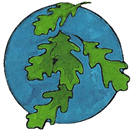


™
- Trees
- A-Z scientific
- A-Z by Common Name
- Families
- Aceraceae Maple Family
- Anacardiaceae Sumac Family
- Annonaceae Custard Apple Family
- Aquifoliaceae Holly Family
- Arecaceae, Palm Family
- Betulaceae Birch family
- Bignoniaceae Trumpet Creeper Family
- Burseraceae Frankincense Family
- Caprifoliaceae Honeysuckle Family
- Chrysobalanaceae Coco-plum Family
- Cornaceae Dogwood Family
- Cupressaceae Cypress Family
- Cyrillaceae Cyrilla Family
- Ebenaceae Ebony Family
- Ericaceae Heath Family
- Fabaceae Pea Family
- Fagaceae Beech Family
- Hamamelidaceae Witch Hazel Ffamily
- Hippocastanaceae Horse Chestnut Family
- Juglandaceae Walnut Family
- Lauraceae Laurel Family
- Leitneriaceae Corkwood Family
- Magnoliaceae Magnolia Family
- Meliaceae Mahogany Family
- Moraceae Mulberry Family
- Myricaceae Bayberry Family
- Myrsinaceae Myrsine Family
- Myrtaceae Myrtle Family
- Nyctaginaceae Four Oclock Family
- Olacaceae Olax Family
- Oleaceae Olive Family
- Pinaceae Pine Family
- Platanaceae Plane Tree Family
- Polygonaceae Buckwheat Family
- Rhamnaceae Buckthorn Family
- Rosaceae Rose Family
- Rubiaceae Madder Family
- Rutaceae Rue Family
- Salicaceae Willow Family
- Sapindaceae Soapberry Family
- Sapotaceae Sapodilla Family
- Simaroubaceae Quassia Family
- Styracaceae Storax Family
- Symplocaceae Sweetleaf Family
- Theaceae Tea Family
- Tiliaceae Lindon Family
- Ulmaceae Elm Family
- Taxaceae Yew Family
- Yucca Family
- Browse by State
- Rare or Endangered Species
- Trees_with_Special_Uses
- Tallest and Biggest
- Noxious Weeds
- Causes
- About Us
- Our Stores
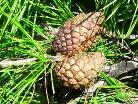

Custom Search
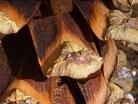
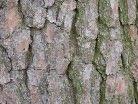
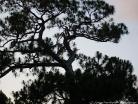
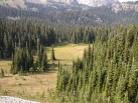
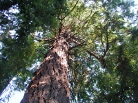
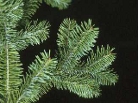
• View Pine Species Profiles:
by Species Boxes:
Click to enlarge

• View Fir Species Profiles:
by Species Boxes:
Click to enlarge
Pine family genera:
• Pine, Pinus
• Spruce, Picea
• Larch, Larix
• Hemlock, Tsuga
• True Firs, Abies
• Douglas Fir, Pseudotsuga



